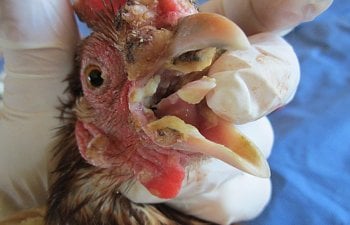Fowl pox symptoms, treatment and prevention
Fowlpox is a viral disease affecting most species of poultry. It is a relatively slow-spreading disease that affects most birds like Chickens, turkeys, pheasants, quail, ducks, psittacine, and ratites of all ages (except newly-hatched chicks). This disease has fewer fatalities. It often passes through a flock unnoticed to the novice chicken keeper.
Other names for fowl pox:**
chickenpox (not to be confused with chickenpox in humans; the human disease does not affect poultry and vice versa), sore head, avian diphtheria, bird pox. Also read: How to Stop watery whitish, greenish, brownish-yellow and bloodstain in your Chickens poops for full Recovery
Types of Fowlpox and their Symptoms
There are two types of fowlpox;
Dry Fowl pox
Dry fowl pox is characterized by raised, wart-like lesions on unfeathered areas (head, legs, vent, etc.). The lesions heal in about 2 weeks. If the scab is removed before healing is complete, the surface beneath is raw and bleeding.
Wet fowl pox
In the wet fowl pox, there are canker-like lesions in the mouth, pharynx, larynx, and trachea. The wet form may cause respiratory distress by obstructing the upper air passages This is the main cause of death from this disease. Chickens may be affected by either or both forms of fowl pox at one time.

Causes of fowlpox in poultry And Mode of Transmission
It is transmitted by direct contact between infected and susceptible birds or by mosquitoes. Virus-containing scabs also can be sloughed from affected birds and serve as a source of infection. The virus can enter the bloodstream through the eye, skin wounds, or respiratory tract. Mosquitoes become infected from feeding on birds with fowl pox in their bloodstream. There is some evidence that the mosquito remains ineffective for life. Mosquitoes are the primary reservoir and spreaders of fowl pox on poultry ranges. Several species of mosquito can transmit fowl pox. Often mosquitoes over-winter in poultry houses, so outbreaks can occur during winter and early spring.
Treatment of Fowlpox
No treatment is available. However, fowl pox is relatively slow-spreading. Thus, it is possible to vaccinate to stop an outbreak.
Prevention of fowlpox in poultry
: Fowlpox outbreaks in poultry confined to houses can be controlled by spraying to kill mosquitoes. However, if fowl pox is endemic in the area, vaccination is recommended. Do not vaccinate unless the disease becomes a problem on a farm or in the area. Chickens may be vaccinated at 4-6 weeks of age using the wing web-stick method, and turkeys older than 8 weeks by the thigh-stick method.
Recovery:
Most individuals with fowl pox will recover and will clear the virus. Recovered birds are not reservoirs of infection. Flocks can recover from infection but the environment must be cleaned before new birds are introduced. Also read: 8 Natural growth boosters/ promoters for broiler that actually worked
6 quick tips to help your chicken recovery from Fowl Pox
1. Keep the chicken pen clean and discard any stagnant water to discourage mosquito breeding. 2. Apply fowl pox natural treatment using natural antibiotics and vitamins. I normally use garlic, lime, and palm oil. For garlic, Put a few pieces of fresh garlic in their water supply. About 2 to 3 pieces of fresh garlic in 3 liters of water is enough. Replenish the garlic in the water supply after 2 or 3 days. You can add ascorbic acid to boost vitamin C. For lime, Scrape the black spot, clean the surface with neem oil, apply palm oil or lime water (not inorganic lime water) on the surface and then give affected bird palm oil. 3. Apply rock salt (kitchen salt) on the affected parts. It will clear off the ugly black spots, although, this is quite excruciating but will do the job faster. Simply put a teaspoon or more of rock salt inside a spray bottle and fill it up with clean water. Spray the mixture on the infected parts of the chicken. Do this twice a day until lesions dry up. 4. Give your chickens only fresh food or feeds 5. Disinfect feeders and drinkers using mild water and bleach solution. This serves as a preventive measure, you should do this at least once a week 6. Isolate affected birds from the rest of the flock for about 4 to 6 weeks Also read: Expected weight of broiler chicken: Are you getting it right?Note: This is a viral disease, there is no cure and birds can only recover through proper management. How long does a fowlpox last vary from the affected bird to the general flock? Individual birds infected with dry pox usually recover in 2 t0 4 weeks, but it may take several weeks or months for the entire flock to recover because the fowlpox virus spread slowly throughout the flock.